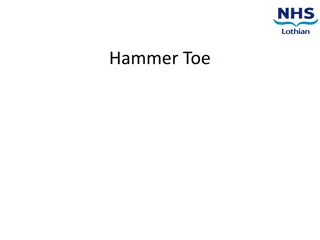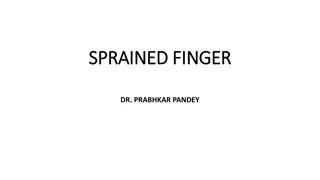Understanding Hallux Rigidus: Causes, Symptoms, Diagnosis, and Management
Hallux Rigidus, a form of big toe arthritis, causes pain, swelling, and reduced movement in the toe joint. It can be triggered by factors like trauma, footwear issues, and family history. Diagnosis involves a physical examination and possible X-rays. Management includes self-care with pain relief, lifestyle changes, and activity modification. Lifestyle and health adjustments, such as maintaining a healthy weight and quitting smoking, can help improve symptoms. Rest and activity modification are key in managing the condition.
Download Presentation

Please find below an Image/Link to download the presentation.
The content on the website is provided AS IS for your information and personal use only. It may not be sold, licensed, or shared on other websites without obtaining consent from the author. Download presentation by click this link. If you encounter any issues during the download, it is possible that the publisher has removed the file from their server.
E N D
Presentation Transcript
Contents 1. What is Hallux Rigidus 2. What are the causes? 3. What are the symptoms? 4. How is it diagnosed? 5. What is the management? 6. How can I manage it?
What is Hallux Rigidus? Hallux Rigidus refers to arthritic changes to the big toe joint.
What are the causes What are the causes? Trauma. Poor or ill fitting footwear. Positive family history. Structural changes within the foot e.g. Hypermobile feet. Affects 1 in 40 individuals aged 50+ years old. 2:1 ratio predisposition affecting females over males.
What are the symptoms? Painful and swollen big toe joint. Reduced movement in the toe. Aggravated when weight bearing, wearing soft-soled shoes or under barefoot conditions.
How is it diagnosed? An appropriate healthcare professional will discuss your foot symptoms and enquire about your general health. A physical examination of your foot will be carried out to assess your movement, response to particular tests and level of pain. This can be clinically diagnosed. An x-ray might be requested for surgical consideration
What is the management? Many patients are happy to self-manage their symptoms, with painkillers/anti-inflammatory medication or other non-invasive treatments such as: Lifestyle and health changes Activity Modification Wearing appropriate footwear. Podiatry
Lifestyle & Health Changes Maintaining a healthy diet and weight Getting 7-9 hours of quality sleep per night Reducing alcohol intake Quit smoking Not all of these recommendations will be relevant to everyone, but these are important factors to consider to optimise your outcome. Click this link for more information and support options
How can I manage it? Rest/immobilisation/activity modification, as required - Example; if pain is caused by running, switching to an activity with less impact such as swimming may help. Simple pain relief or anti- inflammatory medication - Consult your GP or Pharmacist Appropriate footwear - Avoiding high heeled or narrow footwear. Footwear with support may also help symptoms further. Image result for pain relief
Physiotherapy Podiatry Through a thorough examination, a Podiatrist can: Help you establish what may be causing your pain Provide you with an individualised treatment plan to help and/or resolve symptoms. Advise and arrange further investigation, if required
More Invasive Management Options In some cases symptoms may persist and more invasive treatments may be required/requested by you, as the patient: Corticosteroid injection Surgery
Injection Steroid injections: - This is only carried out in some hallux Rigidus cases.
Surgery Surgery is only required if pain is present and symptoms are unable to be controlled by more conservative methods, as described above.























